首页/文章/软件逆向/高版本go语言符号还原/
高版本go语言符号还原
推荐 原创实例版本
2022.6.8: go version go1.18.3 windows/amd64
高版本适用 1.20
还原过程
搜索 go.build
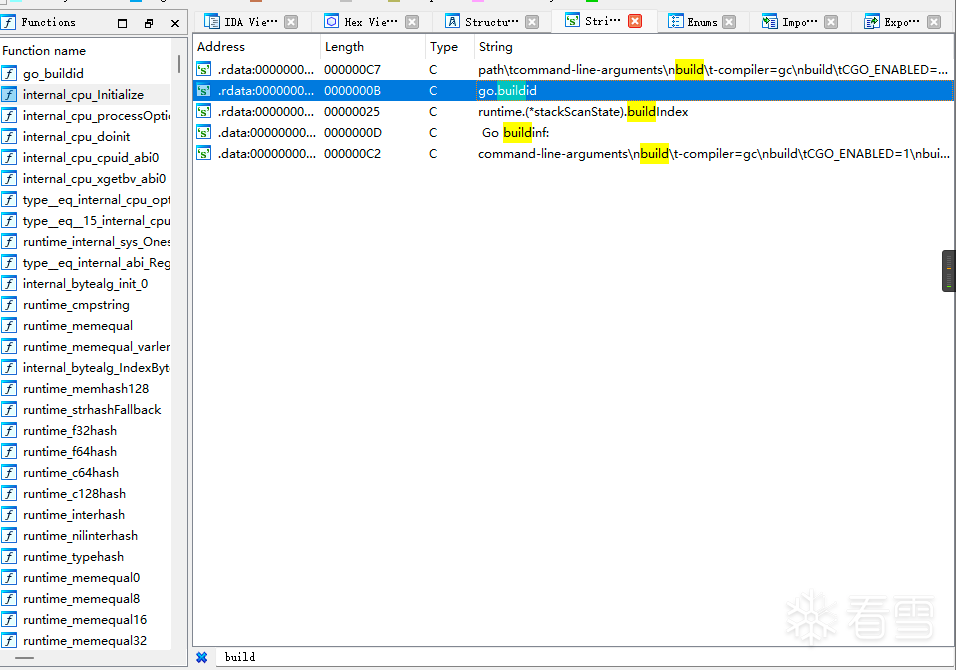
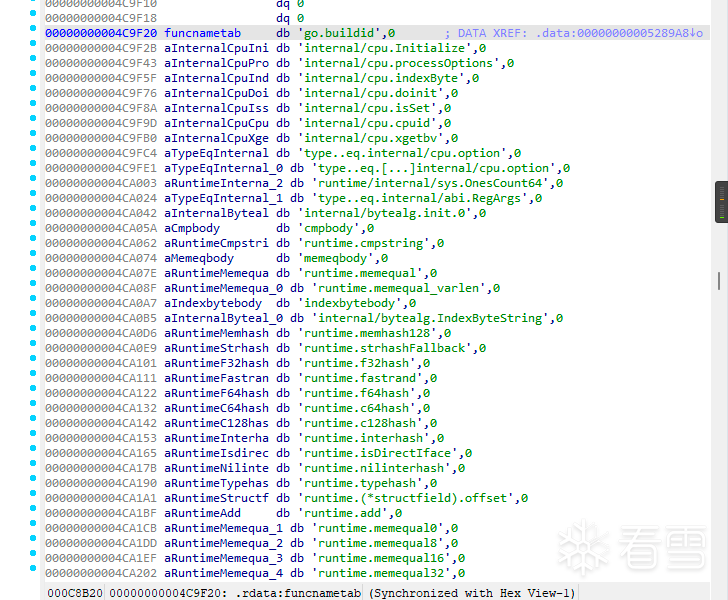
查找交叉引用

go.build 在新版本中一定位于 函数名称的第一个。
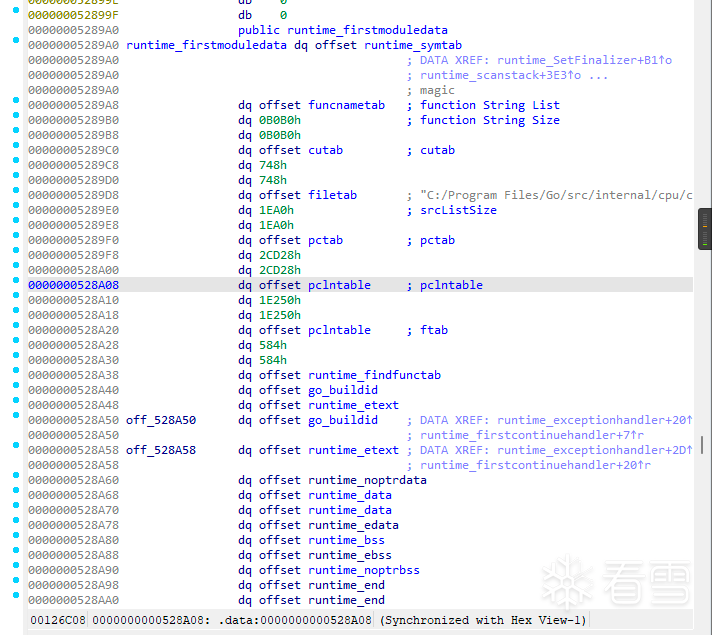
https://go.dev/src/runtime/symtab.go
阅读源码,获取 moduledata 结构
|
1
2
3
4
5
6
7
8
9
10
11
12
13
14
15
16
17
18
19
20
21
22
23
24
25
26
27
28
29
30
31
32
33
34
35
36
37
38
39
40
41
42
43
44
45
46
47
48
49
50
51
52
53
54
55
56
57
58
59
60
61
|
/
/
pcHeader holds data used by the pclntab lookups.
type
pcHeader struct {
magic uint32
/
/
0xFFFFFFF0
pad1, pad2 uint8
/
/
0
,
0
minLC uint8
/
/
min
instruction size
ptrSize uint8
/
/
size of a ptr
in
bytes
nfunc
int
/
/
number of functions
in
the module
nfiles uint
/
/
number of entries
in
the
file
tab
textStart uintptr
/
/
base
for
function entry PC offsets
in
this module, equal to moduledata.text
funcnameOffset uintptr
/
/
offset to the funcnametab variable
from
pcHeader
cuOffset uintptr
/
/
offset to the cutab variable
from
pcHeader
filetabOffset uintptr
/
/
offset to the filetab variable
from
pcHeader
pctabOffset uintptr
/
/
offset to the pctab variable
from
pcHeader
pclnOffset uintptr
/
/
offset to the pclntab variable
from
pcHeader
}
type
moduledata struct {
pcHeader
*
pcHeader
funcnametab []byte
cutab []uint32
filetab []byte
pctab []byte
pclntable []byte
ftab []functab
findfunctab uintptr
minpc, maxpc uintptr
text, etext uintptr
noptrdata, enoptrdata uintptr
data, edata uintptr
bss, ebss uintptr
noptrbss, enoptrbss uintptr
end, gcdata, gcbss uintptr
types, etypes uintptr
rodata uintptr
gofunc uintptr
/
/
go.func.
*
textsectmap []textsect
typelinks []int32
/
/
offsets
from
types
itablinks []
*
itab
ptab []ptabEntry
pluginpath string
pkghashes []modulehash
modulename string
modulehashes []modulehash
hasmain uint8
/
/
1
if
module contains the main function,
0
otherwise
gcdatamask, gcbssmask bitvector
typemap
map
[typeOff]
*
_type
/
/
offset to
*
_rtype
in
previous module
bad
bool
/
/
module failed to load
and
should be ignored
next
*
moduledata
}
|
pclntable 一般等于 ftab, 参照上图, ftab 与 pclntable 填充的是 pclntable 的值。
funcnametab 填充的是 函数名称
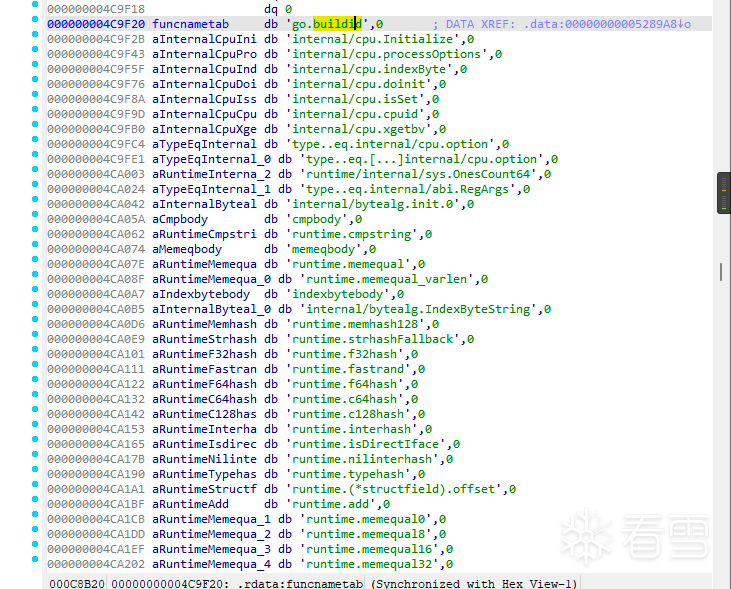
filetab 填充的是 文件名称
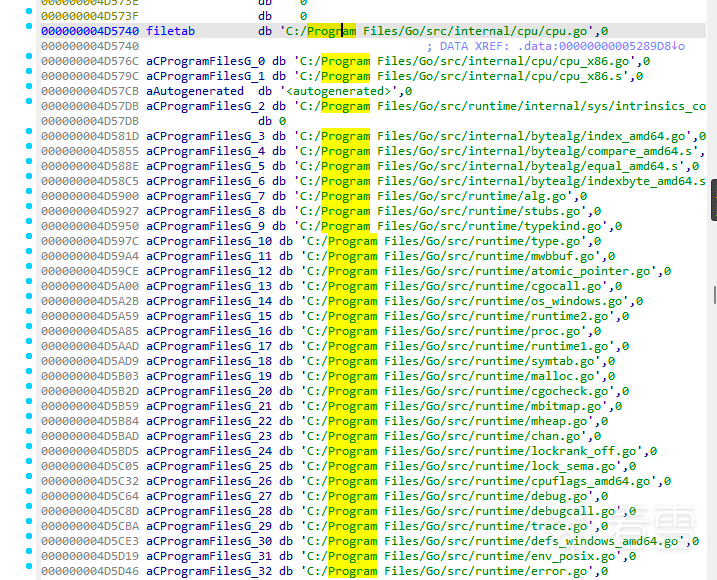
与函数名称相关的是 ftab 和 pclntable
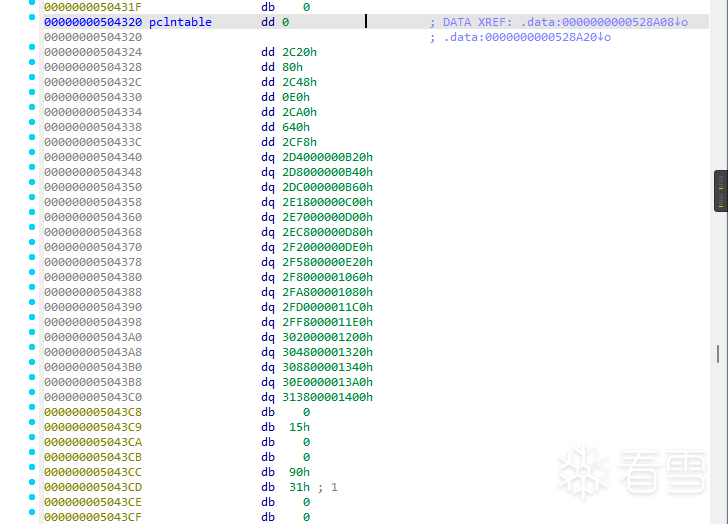
适用于下面的结构体
|
1
2
3
4
|
type
functab struct {
entryoff uint32
/
/
relative to runtime.text
funcoff uint32
}
|
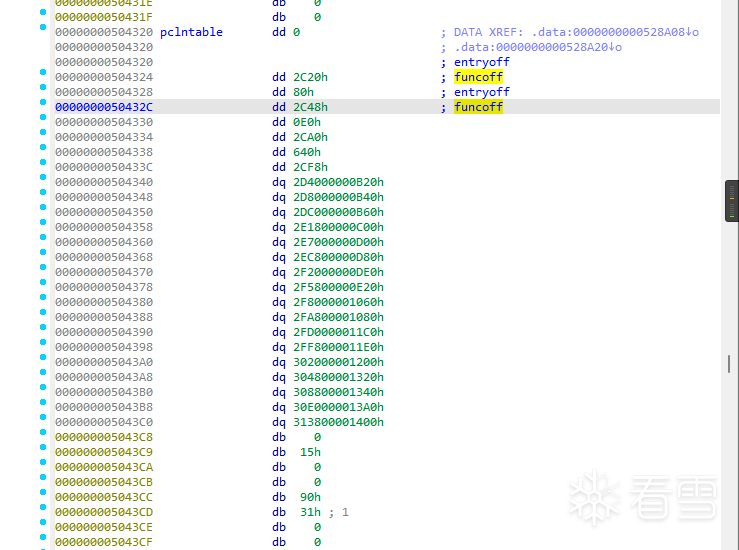
entryoff 为 以代码段为起始位置 的偏移。表示该函数实际的位置。 代码段在windows为 text
funcoff 为 以 pclntable 为起始位置的偏移。
|
1
2
3
4
5
6
7
8
9
10
11
12
13
14
15
16
17
18
19
20
21
22
23
24
25
26
27
28
|
/
/
src\runtime\symtab.go
type
functab struct {
entry uintptr
funcoff uintptr
}
type
funcInfo struct {
*
_func
datap
*
moduledata
}
/
/
src\runtime\runtime2.go
type
_func struct {
entry uintptr
/
/
start pc
nameoff int32
/
/
function name
args int32
/
/
in
/
out args size
deferreturn uint32
/
/
offset of start of a deferreturn call instruction
from
entry,
if
any
.
pcsp uint32
pcfile uint32
pcln uint32
npcdata uint32
cuOffset uint32
/
/
runtime.cutab offset of this function's CU
funcID funcID
/
/
set
for
certain special runtime functions
_ [
2
]byte
/
/
pad
nfuncdata uint8
/
/
must be last
}
|
意思就是: func 的 _func = pclntable + funcOff
通过上图的信息计算:
|
1
2
|
hex
(
0x504320
+
0x2c20
)
=
'0x506f40'
hex
(
0x504320
+
0x2c48
)
=
'0x506f68'
|
发现刚好可以对得上信息
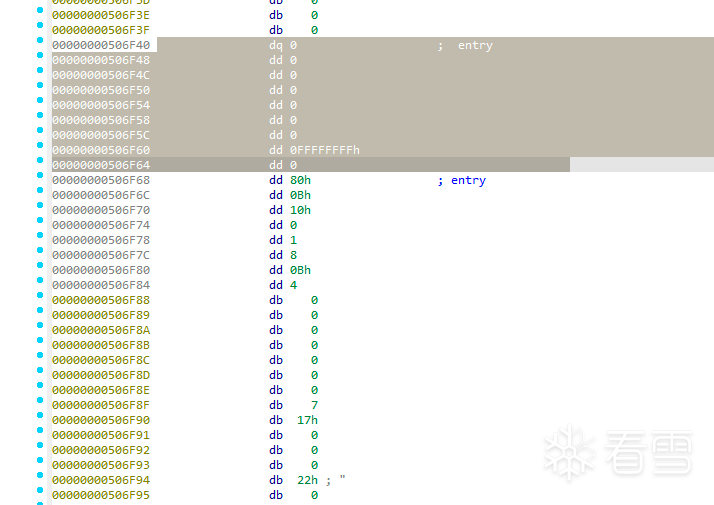
第一个函数 go.build

第二个函数 internal_cpu_Initialize
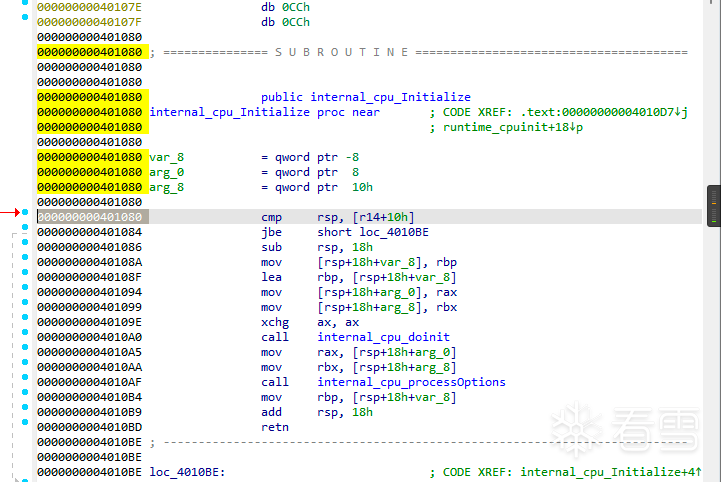
输出脚本
知道了这些就可以编写简单的脚本来还原go符号名了
ida python 脚本
|
1
2
3
4
5
6
7
8
9
10
11
12
13
14
15
16
17
18
19
20
21
22
23
24
25
26
27
28
29
30
31
32
33
34
35
36
37
38
39
40
41
42
43
44
45
46
47
48
49
50
51
52
53
54
55
56
57
58
59
60
61
62
63
64
65
66
67
68
69
70
71
|
import
idc
from
idc
import
*
import
ida_nalt
moduledata_addr
=
0x05289C0
pcHeader_addr
=
idc.get_qword(moduledata_addr)
if
idc.get_wide_dword(pcHeader_addr) !
=
0x0FFFFFFF0
:
print
(idc.get_wide_dword(pcHeader_addr))
print
(
"错误,并不是一个正确的go文件"
)
funcnametable_addr
=
idc.get_qword(moduledata_addr
+
8
)
filetab_addr
=
idc.get_qword(moduledata_addr
+
8
+
((
8
*
3
)
*
2
))
pclntable_addr
=
idc.get_qword(moduledata_addr
+
8
+
((
8
*
3
)
*
4
))
pclntable_size
=
idc.get_qword(moduledata_addr
+
8
+
((
8
*
3
)
*
4
)
+
(
8
*
4
))
set_name(moduledata_addr,
"firstmoduledata"
)
set_name(funcnametable_addr,
"funcnametable"
)
set_name(filetab_addr,
"filetab"
)
set_name(pclntable_addr,
"pclntable"
)
print
(pclntable_size)
def
readString(addr):
ea
=
addr
res
=
''
cur_ea_db
=
get_db_byte(ea)
while
cur_ea_db !
=
0
and
cur_ea_db !
=
0xff
:
res
+
=
chr
(cur_ea_db)
ea
+
=
1
cur_ea_db
=
get_db_byte(ea)
return
res
def
relaxName(name):
# 将函数名称改成ida 支持的字符串
#print(name)
if
type
(name) !
=
str
:
name
=
name.decode()
name
=
name.replace(
'.'
,
'_'
).replace(
"<-"
,
'_chan_left_'
).replace(
'*'
,
'_ptr_'
).replace(
'-'
,
'_'
).replace(
';'
,'
').replace('
"
', '
').replace('
\\
', '
')
name
=
name.replace(
'('
, '
').replace('
)
', '
').replace('
/
', '
_
').replace('
', '
_
').replace('
,
', '
comma
').replace('
{
','
').replace('
}
', '
').replace('
[
', '
').replace('
]
', '
')
return
name
cur_addr
=
0
for
i
in
range
(pclntable_size):
# 获取函数信息表
cur_addr
=
pclntable_addr
+
(i
*
8
)
# 获取函数入口偏移
funcentryOff
=
get_wide_dword(cur_addr)
funcoff
=
get_wide_dword(cur_addr
+
4
)
funcInfo_addr
=
pclntable_addr
+
funcoff
funcentry_addr
=
get_wide_dword(funcInfo_addr)
funnameoff
=
get_wide_dword(funcInfo_addr
+
4
)
funname_addr
=
funcnametable_addr
+
funnameoff
funname
=
readString(funname_addr)
# 真实函数地址
truefuncname
=
relaxName(funname)
truefuncentry
=
ida_nalt.get_imagebase()
+
0x1000
+
funcentryOff
print
(
hex
(truefuncentry),
hex
(funcoff),
hex
(funcInfo_addr),
hex
(funcentry_addr),
hex
(funnameoff),
hex
(funname_addr) ,funname)
# 改名
set_name(truefuncentry, truefuncname)
#print(hex(cur_addr))
|
其中 moduledata_addr 需要手动填充。
还原效果
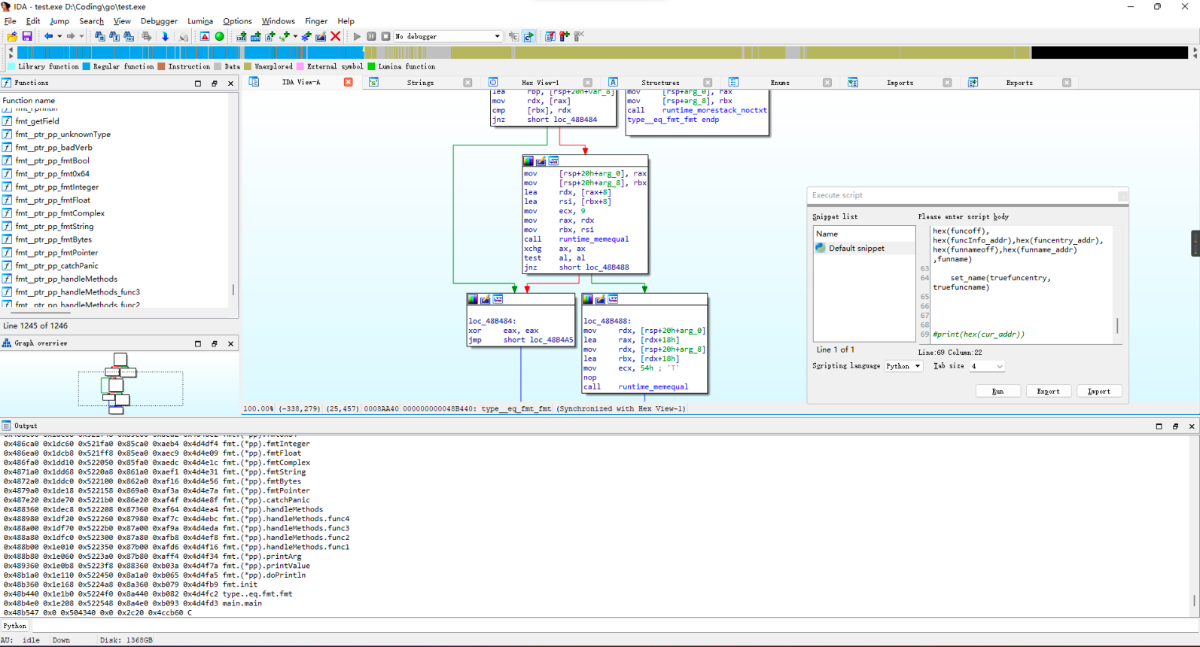
参考链接
更多【高版本go语言符号还原】相关视频教程:www.yxfzedu.com
相关文章推荐
- 二进制漏洞-零基础入门V8——CVE-2021-38001漏洞利用 - PwnHarmonyOSWeb安全软件逆向
- 二进制漏洞-初探内核漏洞:HEVD学习笔记——UAF - PwnHarmonyOSWeb安全软件逆向
- Pwn-glibc高版本堆题攻击之safe unlink - PwnHarmonyOSWeb安全软件逆向
- 二进制漏洞-CVE-2020-1054提权漏洞学习笔记 - PwnHarmonyOSWeb安全软件逆向
- 二进制漏洞-初探内核漏洞:HEVD学习笔记——BufferOverflowNonPagedPool - PwnHarmonyOSWeb安全软件逆向
- CTF对抗-2022DASCTF Apr X FATE 防疫挑战赛-Reverse-奇怪的交易 - PwnHarmonyOSWeb安全软件逆向
- 编程技术-一个规避安装包在当前目录下被DLL劫持的想法 - PwnHarmonyOSWeb安全软件逆向
- CTF对抗-sql注入学习笔记 - PwnHarmonyOSWeb安全软件逆向
- Pwn-DamCTF and Midnight Sun CTF Qualifiers pwn部分wp - PwnHarmonyOSWeb安全软件逆向
- 软件逆向-OLLVM-deflat 脚本学习 - PwnHarmonyOSWeb安全软件逆向
- 软件逆向-3CX供应链攻击样本分析 - PwnHarmonyOSWeb安全软件逆向
- Android安全-某艺TV版 apk 破解去广告及源码分析 - PwnHarmonyOSWeb安全软件逆向
- Pwn-Hack-A-Sat 4 Qualifiers pwn部分wp - PwnHarmonyOSWeb安全软件逆向
- 二进制漏洞- AFL 源代码速通笔记 - PwnHarmonyOSWeb安全软件逆向
- 二进制漏洞-Netatalk CVE-2018-1160 复现及漏洞利用思路 - PwnHarmonyOSWeb安全软件逆向
- 二进制漏洞-DynamoRIO源码分析(一)--劫持进程 - PwnHarmonyOSWeb安全软件逆向
- 二进制漏洞-通用shellcode开发原理与实践 - PwnHarmonyOSWeb安全软件逆向
- Android安全-frida-server运行报错问题的解决 - PwnHarmonyOSWeb安全软件逆向
- Android安全-记一次中联X科的试岗实战项目 - PwnHarmonyOSWeb安全软件逆向
- Android安全-对SM-P200平板的root记录 - PwnHarmonyOSWeb安全软件逆向
记录自己的技术轨迹
文章规则:
1):文章标题请尽量与文章内容相符
2):严禁色情、血腥、暴力
3):严禁发布任何形式的广告贴
4):严禁发表关于中国的政治类话题
5):严格遵守中国互联网法律法规
6):有侵权,疑问可发邮件至service@yxfzedu.com
近期原创 更多
- 密码应用-轻量级分组加密算法CRAFT
- 编程技术-二进制明文字符串加密:还原与反还原
- 编程技术-一个 32 位程序的用户空间区域可以有多大?
- 企业安全-AI新能量!FortiGate NGFW面向数据中心全面集成FortiGuard AI 安全服务
- 企业安全-华云安漏洞安全周报【第155期】
- 企业安全-华云安漏洞安全周报【第154期】
- 软件逆向-外星人笔记本键盘USB协议逆向
- 企业安全-IDC《中国热点威胁安全检测与防护解决方案,2023》发布,华云安防钓鱼解决方案获认可
- 企业安全-华云安漏洞安全周报【第156期】
- 编程技术-Cobalt Strike 内存加载执行 Mimikatz 命令研究